
To monitor one's own actions one has to sample the world after one has done an Act; sampling of multiple acts becomes a difficult problem in a pipeline model.
To cope with this the mind must be doing "load balancing" among "multiple threads".
January 24, 2007
| 5.1 | Outline of Topics | ||
| Coarse-grain mind model of intelligent systems | |||
| Why do we need to study architecture in A.I.? | |||
| Architecture and the perception-action loop | |||
| Mutliple levels of processing | |||
| Realtime | |||
| Subsumption architecture: What it is | |||
| Subsumption architecture: What it is | |||
| Subsumption architecture Basics / Examples | |||
| Subsumption architecture Examples II | |||
| Subsumption Architecture: Characteristics | |||
| Where are we headed? | |||
| Large integrated systems | |||
| Remote Agent | |||
| Brain research architecture: Kosslyn & Koenig | |||
| HONDA Asimo | |||
| Tools | |||
| 5.2 |
Coarse-grain mind model of intelligent systems | |
| Sensation | What comes in through the senses - "raw information" (processed data) | |
| Perception | Includes interpretation and decisions about the sensory data | |
| Interpretation | Interpret the perceptual data in context with knowledge and experience | |
| Decision | Interpretation, decision making and planning are often intermixed. A simplification includes an initial decision between interpretation and planning, the decision to act. | |
| Planning | The (mental and physical) act of deciding future actions | |
| Action | The execution of a decision/plan | |
| Goals | It is generally considered necesssary to model all cognitive agents as having goals; without goals comparisons between choices cannot be made and decisions become random. | |
| Memory | Memory is "everywhere" in a mind. Various memories serve various purposes. Nobody knows how the human memory works as a whole. | |
5.3 |
Why do we need to study architecture in A.I.? | |
| (sw)architecture = (hw)architecture | Architecture in A.I. serves the same purpose as architecture when building physical structures Just like in architectures for physical structures, A.I. architectures:
|
|
| A.I. systems get exceedingly complicated | A.I. is among the "new" sciences of complexity: Their subject is more complex than any studied by science to date | |
| intelligence = organization | Intelligence is in essence an organizational matter. An intelligence is defined by components:
|
|
| Science | Complex systems are the next challenge | |
| Engineering | We are headed towards larger and larger systems | |
| Holistic intelligence | Architecture is now among the main stumbling blocks towards understanding holistic intelligence | |
| All naturally intelligent systems perceive, think and act | Perception-Action is about architecture | |
| 5.4 | Architecture & the Perception-Action Loop | |
 |
||
The old pipeline model of
cognitive processing. |
||
| The need for mental "threads" | To monitor one's own actions one has to sample the world after one has done an Act; sampling of multiple acts becomes a difficult problem in a pipeline model. To cope with this the mind must be doing "load balancing" among "multiple threads". |
|
5.5 |
Multiple Levels of Processing |
|
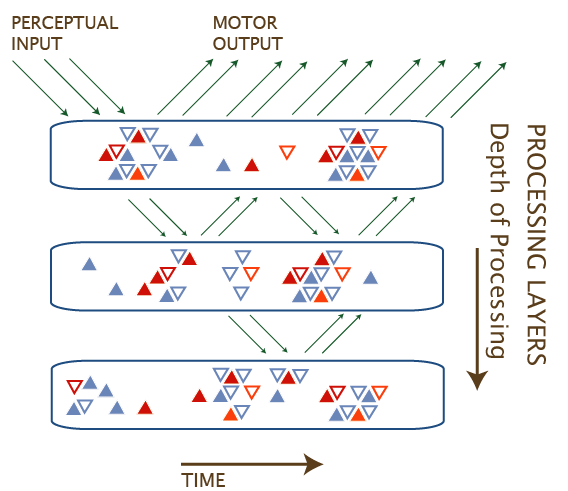 |
||
The new model of layered continuous processing and execution. The top layer provides a quick response time to time-critical perceptual events (a bus coming at you); the middle layer provides a somewhat more thought-out respone set (1-3 second range) while the bottom layer provides a lot of different processing that takes quite a bit more time (e.g. remembering the name of that singer from the 50s). |
||
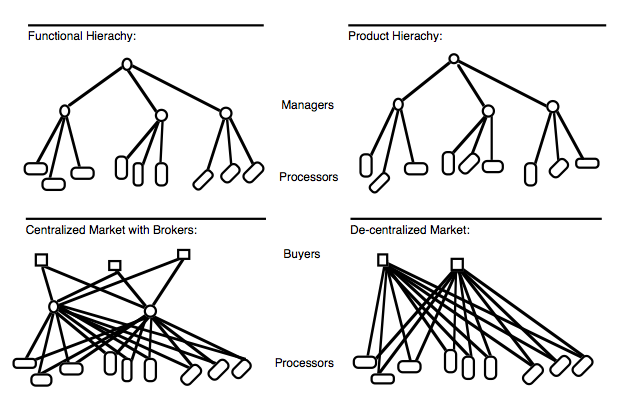 |
||
Coordination hierachies: A functional hierarchy organizes the execution of tasks according to their functions. A product hierarchy organizes production in little units, each focused on a particular product. Several types of markets exist - here two idealized versions are show, without and with brokers. De-centralized markets require more intelligence to be present in the nodes, which can be aleviated by brokers. Brokers, however, present weak points in the system: If you have a system with only 2 brokers mediating between processors and consumers/buyers, failure in these 2 points will render the system useless. Notice that in a basic program written in C++ every single character is such a potential point of failure, which is why bugs are so common in standard software. The human and animal minds are probably ... a mixture of all of these. At the gross anatomical level the brain is a functional hierarchy, with motor control and perceptual inputs in specific places (vision, for example, is always in the back of your head -- no execptions, while language is in the left hemisphere in most people).
|
||
| 5.6 |
Realtime | |
| Perception-Action Loop | A question of realtime | |
Realtime just means "real fast". Right? |
||
| To achieve realtime |
|
|
| 5.7 | Subsumption architecture: What it is | |
| What it is | Robot control architecture system developed at the MIT AI Lab by Rodney Brooks | |
| why it exists | An effort to shift attention from human-level intelligence to simpler organisms, and in the process create the simplest possible architecture that could express intelligent behavior. | |
| how we will use it | You will study the subsumption architecture to a sufficient degree that you can implement it in Java or C++ to control the CADIA Hexapod in your final project. | |
| 5.8 | Subsumption Architecture Basics / Examples | |
| Augmented Finite State Machines (AFSMs) | Finite State Machines, augmented with timers | |
| Modules (FSMs) have internal state | The internal state includes:
|
|
| External environment constists of connections ("wires") |
|
|
| Augmented Finite State Machine (AFSM) with connections |
|
|
Suppressor: Replaces the input to the
module Inhibitor: Stops the output for a given period Reset: Initialization puts the module in its original state |
||
| Augmentation | The finite state machines are augmented with timers. The time is fixed for each I or R, per module. |
|
| Timers | Timers enable modules to behave autonomously based on a (relative) time | |
| The AFSMs are arranged in "layers" | Layers separate functional parts of the architecture from each other | |
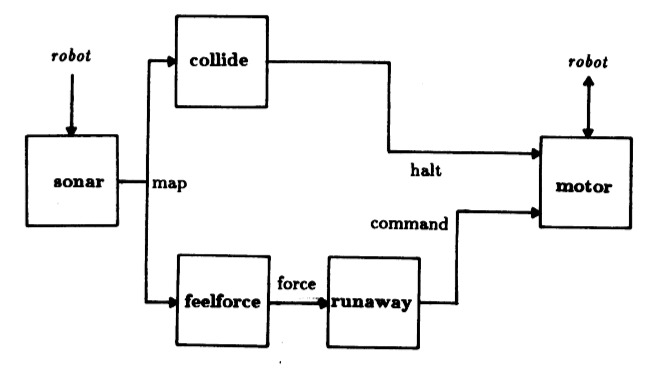 |
||
Level 0 example. |
||
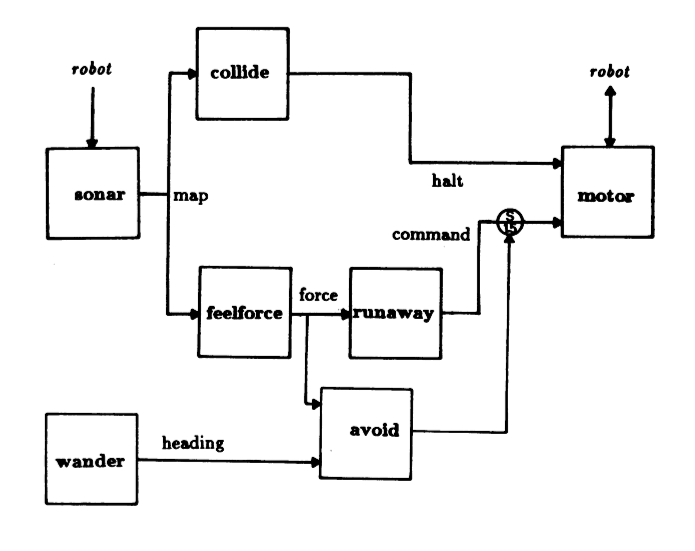 |
||
Level 0 and 1 combined. |
||
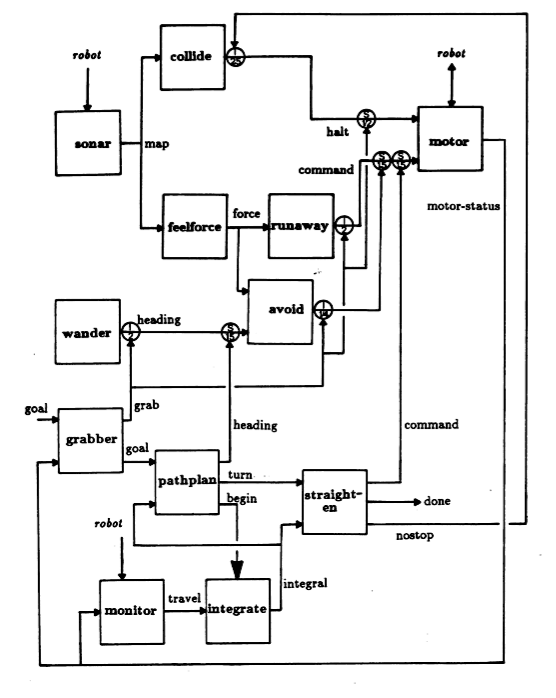 |
||
Level 0, 1 and 2 combined. |
||
5.9 |
Subsumption Architecture Examples II | |
|
||
Example subsumption architecture
with 5 layers. |
||
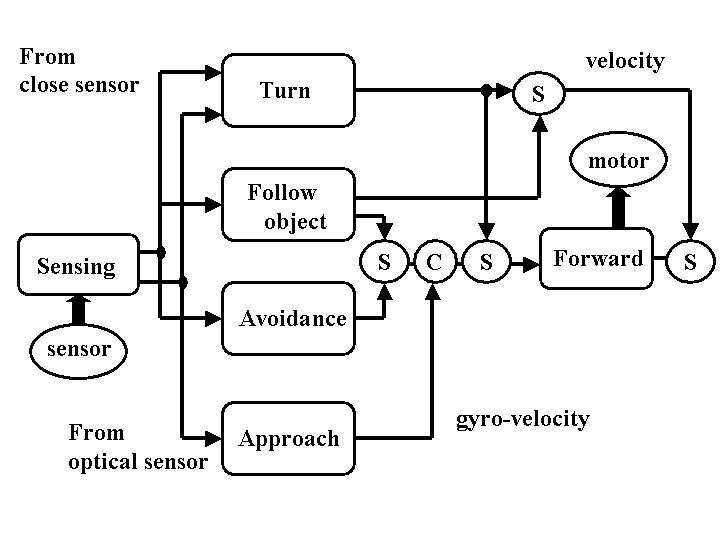 |
||
Example subsumption architecture. |
||
5.10 |
Subsumption Architecture: Characteristics | |
| Architectural characteristics |
|
|
| Behavioral characteristics |
|
|
| Benefits |
|
|
| Drawbacks | Architectures tend to be uniform - it is difficult to extend them beyond controlling simple creatures. Hard to do:
... i.e., it is difficult to construct large architectures that have features of human-level intelligence |
|
| Drawbacks can be overcome through use of Constructionist AI |
Use well-known mechanisms to solve problems they apply well to
|
|
| Constructionist AI results in hybrid architectures | "Hybrid architectures"
|
|
5.11 |
Where are we headed? (next 10-20 years) | |
| Large integrated systems |
Need to build integrated simulations of thinking systems to:
|
|
| Distributed systems | No single computer is up to the task, at present | |
| Manual construction |
|
|
| 5.12 | Large Integrated Systems | |
| Increased autonomy … | …means we are moving towards systems that:
|
|
| Industry examples |
|
|
| Research examples |
|
|
| 5.13 | Remote Agent | |
| Deep Space One | NASA satellite went into orbit on Oct. 24th
1998 |
|
| Deep Space One Remote Agent |
|
|
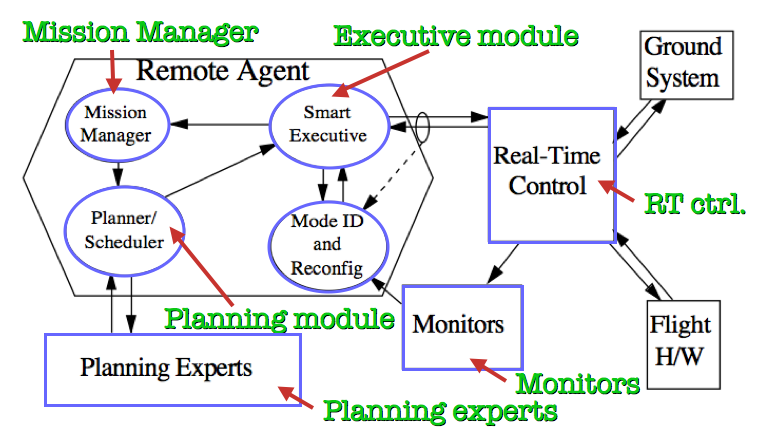 |
||
Deep Space 1 Remote Agent
architecture of main software modules. |
||
| Remote Agent Thought Process Example | Remote Agent knows that:
If a physical thing gets stuck you can try to get it loose by “jiggling” it
|
|
| To think, Remote Agent uses: |
|
|
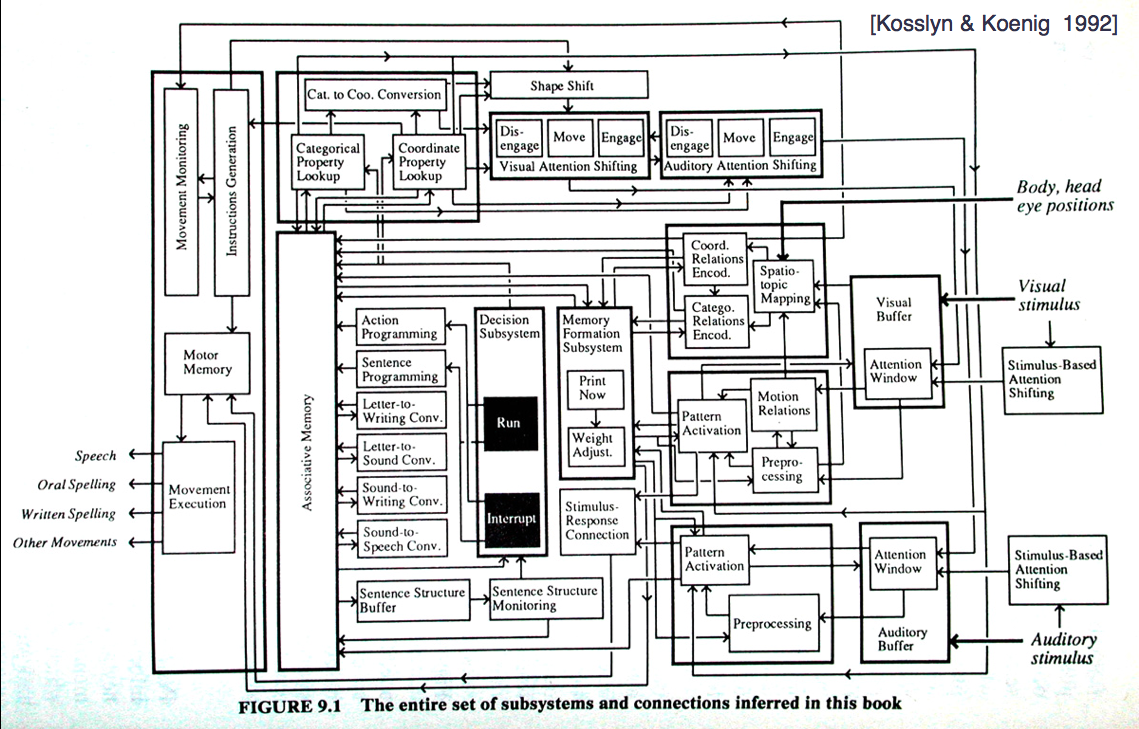
Kosslyn & Koenig architecture. Based on decades of brain research.
5.14 |
Large Complex Systems: HONDA Asimo | |
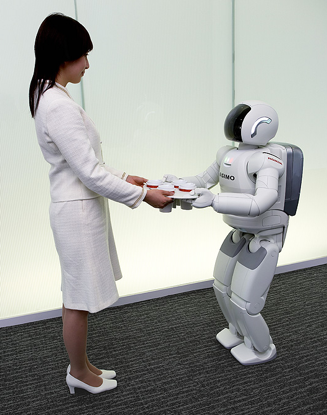 |
||
| Significant progress in last 5-10 years | balance, walking, running | |
| Asimo slated to become a household helper by 2012 |
|
|
| Asimo is an integrated system | Perception, action, balance, planning, object recognition, etc. | |
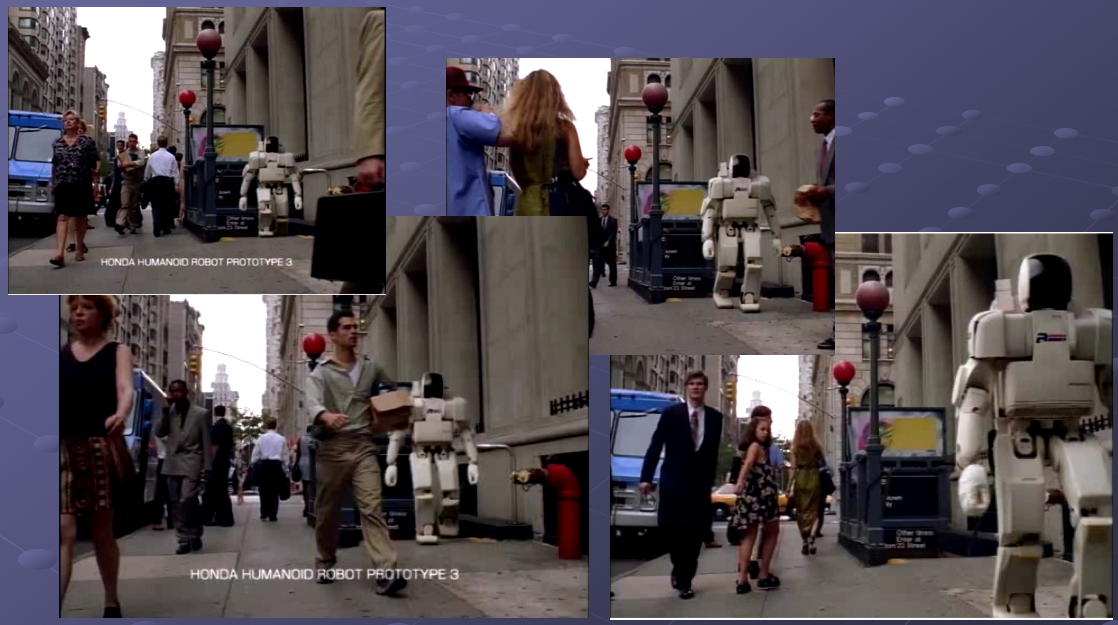
Snapshots from HONDA Asimo video showing Asimo walk out of a subway station in New York City.
5.15 |
Tools | |
| The future is clear: | We need to build large-scale, distributed architectures to study and develop integrated artificial intelligence | |
| Significant lack of good tools to build large-scale, distributed architectures | Most tools in computer science focused on
|
|
Psyclone+OpenAIR |
System explicitly created for large-scale AI development Builds on Constructionist AI |
|